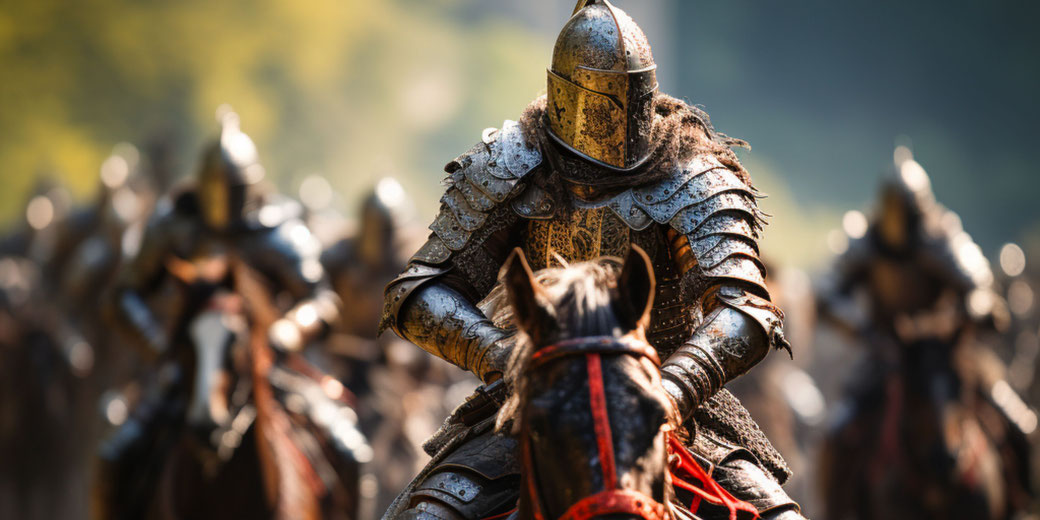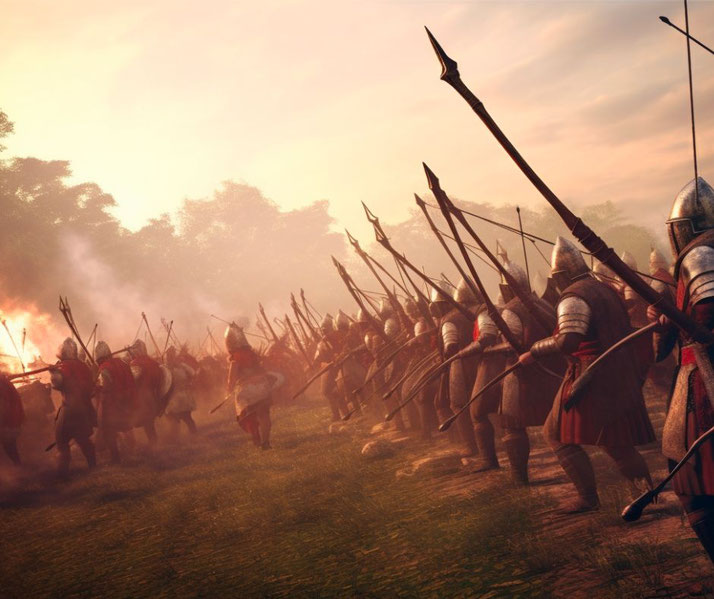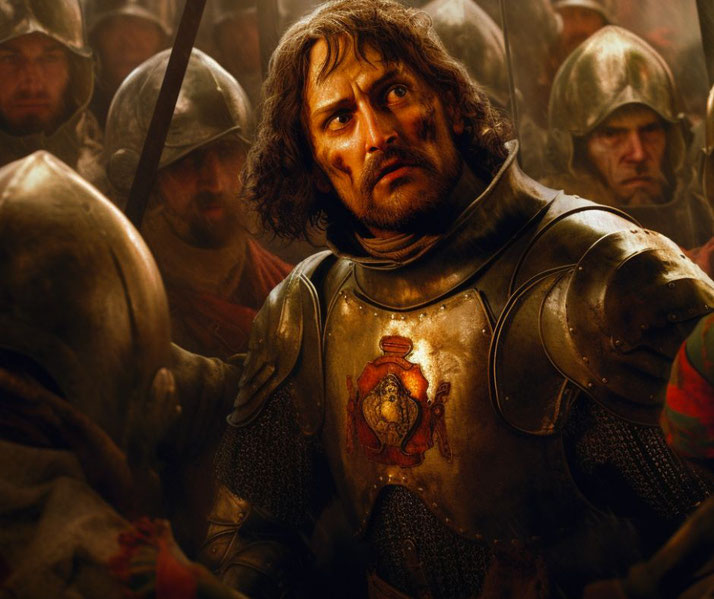The dramatic Battle of Poitiers: Where the Black Prince captured the King of France

The Battle of Poitiers was one of the most pivotal confrontations in the Hundred Years' War, a protracted struggle between England and France that spanned over a century.
Situated near the city of Poitiers in western France, this battle not only showcased the tactical brilliance of Edward, the Black Prince, but also led to the capture of King John II of France, an event that sent shockwaves through the French kingdom and had lasting geopolitical ramifications.
Why were England and France at war?
The Hundred Years' War, a series of conflicts waged from 1337 to 1453, was rooted in territorial disputes and claims to the French throne, with the English Plantagenets and the French Valois at the heart of the struggle.
By the time the Battle of Poitiers rolled around in 1356, the war had already seen significant engagements like the Battle of Crécy in 1346, where the English longbow had proven its devastating effectiveness against French knights.
The region of Aquitaine, a fertile and economically prosperous area, had become a focal point in the conflict.
Controlled by the English but coveted by the French, Aquitaine was more than just a piece of land; it was a symbol of power and legitimacy.
Who led the different armies at Poitiers?
Leading the English forces was Edward, the Black Prince, the eldest son of King Edward III of England.
A seasoned warrior despite his young age, the Black Prince had already proven his mettle in previous battles like Crécy.
Known for his tactical acumen and chivalric virtues, he was the linchpin of the English strategy at Poitiers.
His leadership not only inspired his troops but also effectively utilized the longbowmen, whose role would prove decisive in the battle.

Opposing him was King John II of France, a monarch eager to assert his authority and reclaim territories lost to the English.
Known as John the Good, his reign had been marked by internal strife and external challenges.
The Battle of Poitiers offered him an opportunity for redemption, a chance to prove his military prowess and restore French honor.
On the English side, allies like Captal de Buch, a Gascon nobleman, contributed to the victory, exemplifying the complex web of alliances and loyalties that characterized the Hundred Years' War.
On the French side, knights like Bertrand du Guesclin and Jean de Clermont, who commanded the French vanguard, were emblematic of the chivalric ideals and tactical limitations that influenced the outcome of the battle.
The causes of the Battle of Poitiers
In the months leading up to the Battle of Poitiers, the tension between England and France had reached a boiling point.
Edward, the Black Prince, had been conducting a series of chevauchées across the French countryside, laying waste to villages and farmlands.
These raids served a dual purpose: they weakened the French economy and military morale, while also goading the French into open battle.
The strategy was effective; King John II, eager to reclaim lost territories and restore French honor, took the bait.
He assembled an army with the intent of confronting the English forces and driving them out of French lands once and for all.
As both armies maneuvered through the region, a series of skirmishes and smaller engagements unfolded.
These initial clashes served as a prelude to the larger battle, offering both sides valuable insights into their opponent's tactics and capabilities.
The English, for instance, took note of the French reliance on heavy cavalry, a factor that would significantly influence their own battle plans.
The French, meanwhile, were keenly aware of the devastating effectiveness of the English longbow, having learned harsh lessons from their defeat at the Battle of Crécy a decade earlier.
The crucial differences between the two armies
The composition and capabilities of the English and French armies at the Battle of Poitiers were reflective of their broader military philosophies, shaped by years of conflict and experience.
The English army was a smaller but highly specialized force. It was composed of a mix of dismounted men-at-arms and a significant number of longbowmen.
These longbowmen were the backbone of the English strategy, capable of launching deadly volleys of arrows that could penetrate armor and disrupt enemy formations.
The English also had a contingent of Gascon allies, who were crucial in bolstering their numbers and capabilities.
The French army was considerably larger and comprised mainly of heavy cavalry, including knights and men-at-arms.
These were the flower of French nobility, well-armored and riding powerful warhorses.
The French also had a contingent of Genoese crossbowmen, although they were not as numerous or as strategically integrated as the English longbowmen.
The French military doctrine at the time placed a great deal of emphasis on the shock value of a cavalry charge, a tactic that had been effective in earlier conflicts but was becoming increasingly outdated.
The French army was organized into divisions, known as "battles," each commanded by high-ranking nobles and members of the royal family, including the Dauphin, the future Charles V.

Important details about the battlefield
The terrain of the fields of Maupertuis, near the city of Poitiers, was a crucial factor in the unfolding of the battle, as it offered both opportunities and challenges for the combatants.
The English, aware of their numerical disadvantage, chose a defensive position that maximized the natural features of the landscape.
They positioned themselves on a sloping hill, flanked by thick hedges and a small stand of trees, which not only provided cover but also funneled the French forces into narrow channels, making it difficult for them to effectively deploy their superior numbers.
The French, for their part, found themselves navigating a battlefield that was less than ideal for the kind of massed cavalry charges that were the hallmark of their military strategy.
The narrowness of the field, the natural obstacles, and the uphill gradient all worked against them, complicating their efforts to break the English lines.
Despite these challenges, the French were confident in their numerical superiority and the prowess of their heavy cavalry, believing that they could overwhelm the English positions through sheer force.
How did the English win the Battle of Poitiers?
As dawn broke on September 19, 1356, the English, fortified in their defensive positions, awaited the French assault.
The French, eager to engage and confident in their numerical superiority, prepared to launch their first wave of attacks.
The initial skirmishes were marked by probing maneuvers, as both sides tested each other's defenses and sought to gauge the strength and resolve of their opponents.
The first major engagement came when the French vanguard, led by nobles like Jean de Clermont, launched a cavalry charge aimed at breaking the English lines.
The English longbowmen, positioned strategically behind natural barriers, unleashed a hailstorm of arrows.
The French knights, despite their heavy armor, found themselves stymied by the deadly accuracy and penetrating power of the longbows.
Many were unhorsed, and the charge faltered, failing to break the English lines.
Undeterred, King John II ordered a second wave of attacks, this time involving the main body of the French army.
Again, the English longbowmen played a decisive role, disrupting the French formations and causing mounting casualties.
The English men-at-arms, dismounted and armed for close combat, stood their ground, engaging the French knights who managed to reach their lines.
The fighting was fierce, marked by acts of individual heroism and brutal hand-to-hand combat.

The disastrous capture of King John II
As the battle wore on, it became increasingly clear that the French were struggling to adapt to the unfolding situation.
Their cavalry charges, so effective in open fields, were neutralized by the English defensive positions and the unrelenting volleys of arrows.
In a desperate bid to turn the tide, King John II led a daring charge aimed at penetrating the English defenses.
Accompanied by his elite knights and his youngest son, Philip, the French king managed to reach the English lines, engaging in fierce hand-to-hand combat.
However, the English forces were prepared for such an eventuality. Their men-at-arms, already in a defensive formation, closed ranks and fought back with ferocity.
In the ensuing melee, King John II found himself increasingly isolated as many of his accompanying knights were either killed or incapacitated.
Realizing the gravity of the situation, he fought valiantly, but the odds were overwhelmingly against him.
Eventually, he was captured by English soldiers, including a knight named Denis de Morbecque, according to some historical accounts.

With their king taken prisoner, the French army's morale plummeted, leading to a hasty and disorganized retreat.
The English, sensing victory, pressed their advantage, capturing many French nobles and soldiers.
By the time the sun set on Maupertuis, the field was littered with the dead and wounded, the majority of whom were French.
The English had not only held their ground but had also inflicted a devastating defeat on their adversaries.
Ransoming the king and the Treaty of Brétigny
For the French, the defeat was nothing short of catastrophic. The capture of their king threw the country into a state of political turmoil, exacerbating existing fissures within the nobility and leading to a crisis of leadership.
The Dauphin, the future Charles V, was left to manage the kingdom in his father's absence, a daunting task given the internal and external challenges facing France.
The immediate concern for both sides was the fate of the captured French king and nobles, whose release became the focal point of diplomatic efforts.
The English, sensing an opportunity to extract significant concessions, demanded a hefty ransom for the release of King John II.
The sum, initially set at 4 million écus, was an astronomical amount that placed a severe strain on the French economy.
To raise the funds, the French crown had to levy additional taxes, leading to widespread discontent and social unrest among the populace.
The resulting Treaty of Brétigny of 1360, which aimed to bring a temporary halt to hostilities, was more than just a ransom agreement.
It also included territorial concessions, with the English gaining control over vast tracts of land in southwestern France, including key regions in Aquitaine.
In return, Edward III renounced his claim to the French throne, a claim that had been one of the underlying causes of the Hundred Years' War.
Why was the Battle of Poitiers so significant?
The Battle of Poitiers was a watershed moment in medieval warfare, influencing tactical doctrines and military strategies for years to come.
The effectiveness of the English longbow, demonstrated so vividly at Poitiers, led to a reevaluation of infantry tactics and the role of archers in battle.
Conversely, the French were forced to reconsider their reliance on heavy cavalry and the chivalric ideals that had long dominated their approach to warfare.
The lessons learned on the fields of Maupertuis were studied and incorporated into the military thinking of subsequent generations, shaping the evolution of European warfare.
Politically, the battle had immediate and long-lasting repercussions. The capture of King John II created a power vacuum in France, exacerbating internal divisions and leading to a period of instability and reform.
The ransom demands placed a heavy financial burden on the French state, affecting its economy and social fabric.
For the English, the victory at Poitiers bolstered national morale and solidified their territorial gains in France, although it did not bring a decisive end to the Hundred Years' War.
The Treaty of Brétigny, while temporarily halting hostilities, failed to address the underlying causes of the conflict, setting the stage for further battles and negotiations.
What do you need help with?
Download ready-to-use digital learning resources
Copyright © History Skills 2014-2024.
Contact via email
With the exception of links to external sites, some historical sources and extracts from specific publications, all content on this website is copyrighted by History Skills. This content may not be copied, republished or redistributed without written permission from the website creator. Please use the Contact page to obtain relevant permission.





